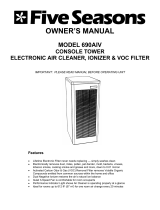
69-0756B—2
Odors are gases, not particles. They cannot be
removed by the air cleaner or by any other filter
designed to remove particles. However, some
gases can be trapped by an activated carbon
filter or diluted with outdoor air. If odors are a
concern, talk to your heating and air condition-
ing dealer about installing a carbon filter
downstream of the air cleaner or providing an
outdoor air inlet.
Use a carbon
filter to remove
odors
Air ionizers have been marketed with claims
about purifying the air and promising medical
benefits. It should be noted that supporting tests,
if available, are controversial and incomplete.
Air ionizers may generate a bit of ozone, and of
course some ions (air molecules with an electric
charge). This is what your electronic air
cleaner’s ionizer does, but with greater inten-
sity. However, air ionizers do not have good
collectors, if any. With air ionizers, the charged
dirt particles are
collected
by walls, floor and
furniture, requiring frequent cleaning of the
entire building to remove the effects of collected
contamination. By comparison, an electronic air
cleaner deposits contamination on the cell(s)
and prefilter(s) for easy cleaning.
Electronic air cleaners generate a very small
amount of ozone, about 0.005 to 0.010 parts
per million (ppm). The amount is highest when
the air cleaner is new.
The average person can detect the odor of
ozone in concentrations as low as 0.003 to
0.010 ppm. The U.S. Food and Drug Adminis-
tration, and Health and Welfare Canada
recommend that indoor ozone concentration
should not exceed 0.050 ppm. As a compari-
son, the outdoor ozone level in major cities is
sometimes higher than 0.100 ppm.
The electronic
air cleaner
versus the air
ionizer
Ozone and the
electronic
air cleaner
16





















